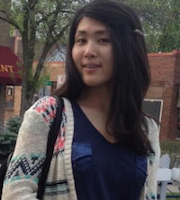Violent television may make children more susceptible to advertising messages
A study by a University of Wisconsin–Madison journalism researcher has found that children who watch television shows with action or violence are more susceptible to messages in the advertisements shown during the programs.
Eunji Cho, a graduate student in UW–Madison’s School of Journalism and Mass Communication, says the excitement of a violent show causes children to be focused and attentive, an effect that carries over to commercial breaks.

Eunji Cho
To perform this study, Cho returned to her native South Korea and observed four different kindergarten classes. Each class was randomly assigned to watch either “Teenage Mutant Ninja Turtles” or “A Dog of Flanders,” a calm Japanese program. The kids were then shown an ad for chocolate at commercial breaks.
Afterward, the children were asked to choose which candy bar they wanted — the one advertised in the commercials or a generic brand. Cho found that students who watched the violent show overwhelmingly favored the advertised product, while those who watched the calm show were indifferent about which candy bar they chose.
She also discovered that children who watched “Teenage Mutant Ninja Turtles” remembered the details of the advertisement better than those who watched “A Dog of Flanders.” They exhibited a higher brand preference and purchase intention than those who watched the nonviolent program.
Cho says the study shows how important it is for children to be defensive when it comes to advertising.
“We have to teach children what is advertised here. Sometimes they get confused between TV programs and advertising.”
Eunji Cho
“We have to teach children what is advertised here. Sometimes they get confused between TV programs and advertising,” Cho says. “When they watch advertising, they have to be ready.”
Cho hasn’t always been on the research side of advertising. After getting a bachelor’s degree in communication and media from Seoul Women’s University, she worked for Diamond Ogilvy Group, the Korean branch of worldwide ad company Ogilvy & Mather. She spent three years there as an accounting executive, planning global advertising campaigns for clients such as Nike and LG Mobile.
Wanting to learn more and see advertising from the other side, Cho left the industry to attend graduate school. Upon getting her master’s degree from the University of Texas at Austin, Cho began working toward her doctorate at UW–Madison in 2010.
It was here that her perspective changed.
“I was really on the marketing side,” Cho says. “I would always think about how we sell more products, what can be better strategies to attract more people.”
Cho developed a special interest in how mass media affects youth through advertising thanks to a course taught by Karyn Riddle, an associate professor at the School of Journalism and Mass Communication. Riddle later became Cho’s advisor on her research.
“The fact that (Cho) did this project on her own (was) really ambitious,” Riddle says. “A lot of grad students (will) wait until their advisor initiates a study, but she initiated this.”
In collaboration with Seung-Chul Yoo, an assistant professor of digital advertising at Loyola University in Chicago, Cho published her findings earlier this fall in the International Journal of Advertising.
—Jim Dayton


